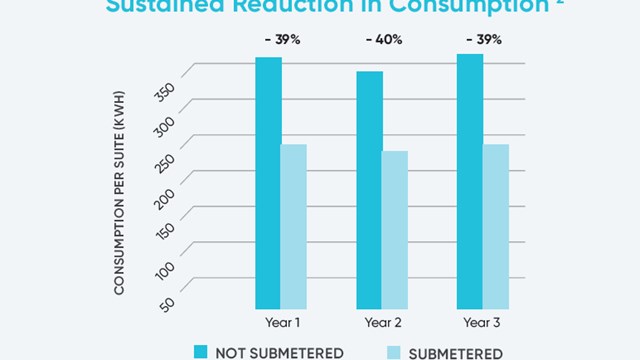
The billing system used by New York City's Water Board - an autonomous, seven-member panel appointed by the mayor to set rates for the city's water and sewer services - has long been grounds for heated debate. As of the late 1980s, the city was one of the last urban areas to still charge customers a flat rate charge for water used. However, studies showed that New York City's per capita water consumption was the highest among the nation's urban areas.
In an effort to conserve precious H2O, officials with the New York City Department of Environmental Protection (DEP) announced in 1988 that within 10 years, every residential building in the city would be required to have a water meter as part of the new "Multi-Family Conservation Program," or MCP. This program would replace the "frontage," or flat-rate, system, which was based on such variables as number of units in the building, number of bathrooms, number of plumbing fixtures, width of building and other information.
This past June, the DEP announced that the Water Board plans to extend the deadline for buildings to choose between metered and the new MCP version of the flat rate. By June 30, 2006, buildings wishing to participate in the program will need to be in compliance with the program's requirements. By July of 2006, multiple dwelling buildings of six or more units must either have at least 70 percent of their plumbing fixtures and hardware converted to energy-conserving versions or they will be switched automatically to metered billing.
The objective? According to the DEP, the idea is "To promote water conservation in multi-family buildings and to give owners of such buildings a measure of control over their water and sewer costs, while at the same time being revenue neutral relative to the water system as a whole and to other customer classes."
If a building is permitted to enter the MCP Program, it will be charged $517.69 per dwelling unit, according to William Kusterbeck, treasurer for the Water Board. The old method of billing, "frontage," will no longer be used by the board.
According to the "Program Overview" offered on the DEP's website, the MCP was born in 1999, and "offers owners of multiple family housing consisting of six or more dwelling units an option to elect billing based on a fixed charge per dwelling unit in lieu of metered billing, if the owner invests in low-consumption plumbing hardware and fixtures and cooperates with DEP in conservation efforts in their buildings."
The path to this recent development has hardly been free of controversy. While simple metering would seem to make water charges more equitable between buildings, installing a single meter for each building would not allow for a means of calculating how much water each individual unit actually consumed; the building's total water bill would be split evenly amongst all units, regardless of differences in water usage. Few would argue that it's only fair for each resident in a multi-family building to pay for the water that those living in their unit actually use. This is where the idea of water "submetering" - installing individual meters for each unit - comes up.
Unfortunately, most aging New York City residential buildings are just not structured to accommodate splitting water meters to all of the tenants. Typically these older-style buildings use a "riser" system of plumbing where the water comes into the basement and is sent up to bathroom and kitchen risers throughout the building. As a result, according to Michael Lockhart, president of American Telephone and Utility Consultants - a utility auditing company in Manhattan - submetering would be almost impossible.
Also complicating the issue is Section 1045, 2A, of the Public Authorities Law of New York, which states that, unlike electric charges, water charges are charged to the property, not to individual tenants. In this way, the water company can put a lien on the property if water bills go unpaid.
"We would never let go of the lien feature, since it's a tremendous enforcement mechanism," says Kusterbeck. "Also," he adds, "Section 1045-j(5) of the New York State Public Authorities Law provides that - like real estate taxes - if water and sewer charges are not paid when due are a lien against the property served and a charge against the owners thereof: They are not a direct responsibility of individual tenants. Thus, delinquent water charges result in a statutory lien against the premises, which can impair an owner's title."
The DEP's edict was not exactly met with open arms; though different groups took issue with it for different reasons. Owners of co-ops and condos - who pay indirectly for their building's water usage through their association dues and monthly maintenance fees - were upset that they were being forced to pay equally for a resource they don't necessarily use equally. Real estate lobbying groups, landlord associations and co-op and condo associations argued the inherent inequity of making those who live in multi-family buildings pay equally for the building's water bill when water use varied greatly from resident to resident. Afer all, shouldn't the elderly shareholder in apartment 2B, who uses less water than the family of five in 6A, pass less for her utility bill?
Perhaps the loudest dissent, however, came from the city's rental landlords, who perceived the metered system as a threat to their positive cash flow. Landlords argued that they have no way to control the water their tenants use, outside of installing costly energy-conserving fixtures. Even with these so-called "low-flow" fixtures, it's nearly impossible to prevent a tenant from taking 40-minute showers or from washing four or five loads of clothing per day.
"The landlord has no control of his tenants' bathing habits and flushing frequency, and his tenants have little incentive to conserve water," says Lockhart. "As a result, that landlord is going to be extremely unwilling to go on metered billing. You're putting the landlord in a situation where he has no control over the bills - and then you're penalizing him. Add rent control to that, and the landlord can't even raise the rent to accommodate for the rise in the water rate."
In the early 1990s, the Water Board attempted to smooth some of the ruffled feathers by agreeing to a transition program, which, according to Kusterbeck, was originally intended to offer a bridge between when the meter was installed and when the building would finally move to metered billing, "giving the market time to adjust to the metered billing."
Unfortunately, the Water Board soon realized that the transition program was a failure because they had to extend the program year after year since property owners and landlords were either unable or unwilling to shell out for the expensive infrastructure changes needed to facilitate metered billing and water conservation. Very few property managers were taking care of the ancient, leaky plumbing fixtures in their buildings as they were supposed to.
That is where the Water Board decided to try another tack: the MCP. The idea was to promise continued flat-rate billing to those buildings that agreed to replace old or inefficient fixtures with energy-conserving, low-flow toilets, showerheads and faucets. Toilets, which are generally the biggest culprit in water-wasting, are required to be a low-consumption type (1.6 gallons per flush or less), while showerheads must use no more than 2.5 gallons per minute. Faucets, those found both in the kitchen and bathroom, would flow at 2.5 gallons per minute or less, "either through the design of the faucet or by the installation of a "˜tamper-resistant' aerator" [from guidelines].
"With the MCP program," says Kusterbeck, who was primarily responsible for writing the administrative guidelines for the program, "we tried to accelerate the change-out rate [of older fixtures]. From our point of view, MCP is a reasonable compromise. We need to have the sense that buildings are reasonably conserving."
Although the MCP is intended to be a peace offering in this whole convoluted, long-standing war, many people don't feel that the program offers any benefits to buildings that choose to comply. To date, just a few hundred properties have signed up for this new program.
"The program is very subjective," argues Lockhart, who founded the Coalition for Water Bill Justice, a grassroots organization created to advocate fair billing practices for New York City water customers. "You do work to get on the program - i.e., adding new fixtures - and then the DEP says that they don't think you're complying and they kick you off the program."
Lockhart also bemoans the fact that Section 9 of the program's administrative guidelines states, "DEP will monitor the actual consumption of each property"¦and compare it with the expected consumption for the property."
In order to do this, they require program participants to let DEP employees enter the building, and individual properties, at any time. "Properties will be subject to inspection and increased monitoring for the purpose of explaining the elevated consumption level," reads the document, which Lockhart points out is "a one-sided document where things are written for the benefit of DEP."
The guidelines go on to say that, "The inspection will survey for leaks and waste, continued compliance with program requirements, and review any commercial uses."
"Co-op and condo owners are not going to be keen on Big Brother knocking on their door," quips Lockhart. "The monitoring aspect of this program is somewhat burdensome."
"The MCP program will help those buildings with high tenant density where water conservation is under poor control," according to Alan Rothschild, president of Vantage Group, a water cost management and conservation consulting company. "However, most co-ops really will save money on metered billing - some of them as much as 40 to 50 percent. A lot of co-op board members are still under the impression that metered rates aren't going to help them, but most of my clients save money on metered rates."
An attempt to jumpstart the MCP program was the Toilet Rebate Program of the early and mid-1990s.
"The city basically said, "˜We'll give you a $150 rebate for every old toilet you replace,'" explains Lockhart. "'One day you'll be on metered billing, and then this will help you.'"
But people didn't take advantage of the program as they could have, some alleging that the new toilets didn't match the original décor of the bathrooms and that they had to be flushed two or three times to work properly. Because 60 percent of water conservation is related to the toilet, according to Kusterbeck, the Toilet Rebate Program was considered by some as a good place to start in helping people on the path to conserving water.
"In the next few months, we're considering another Toilet Rebate Program," says Kusterbeck. "I'm 99 percent sure we'll do something, but the question is what the dimensions of the program [will be]."
"You really have to look at it on a cost-to-cost basis," says Josh Cohen, an analyst with Lawrence J. Berger, PC, a firm that has successfully audited New York City water/sewer charges and claims that the DEP often calculates meter usage incorrectly, thus costing residents money.
Cohen adds, "I see myself as an advocate for customers. Owners and cooperators should evaluate where they are financially so that they can project their budget and evaluate the decision to install energy-conserving fixtures [or] remain on metered billing."
It's been a long battle between Water Board members and those who are trying to run profitable buildings in New York City. In trying to achieve profit, it is extremely important for owners, managing agents and board members to understand their water billing options so that they can choose the best billing system for their property.
"The MCP Program is not a one-size-fits-all program," says Kusterbeck. "Each property will need to come to its own conclusion."
If you are interested in applying for the MCP program, or want more information, you can visit any borough office of DEP or call (718) 595-7000 for an application form. You can also download an application from the DEP's website






Leave a Comment